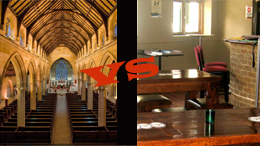“Here is the church, here is the steeple. Open the door, but where are all the people?”
 Discussion about church buildings often focuses on sentimentality and architecture – how sweeping arches, stained glass and exulted altars give us a sense of reverence and spirituality, making us feel ‘closer to God’.
Discussion about church buildings often focuses on sentimentality and architecture – how sweeping arches, stained glass and exulted altars give us a sense of reverence and spirituality, making us feel ‘closer to God’.
At a talk this week on worship in Sydney’s public spaces hosted by the city’s Historic Houses Trust, Wayside Chapel CEO Graham Long raised perhaps a more interesting and relevant discussion point: ‘Where do we meet God?’
His answer reflects a growing trend to abandon the traditional church building as a ‘place of worship’: “You can’t pursue a God who is everywhere to be found.”
That is, we don’t go to church to meet God, because God doesn’t live there. Not in the physical building, anyway. Living there instead, according to some of Australia’s newest church planters, is an institution under community suspicion. At least, that’s the community perception of the traditional, oft-steepled church building.
Auka Rienstra is a church planter in Perth, part of the evangelical 121 degrees church planting network in the city. His church, Redeemer Community Church, has been meeting in The Balmoral Hotel since its launch in May this year. Rienstra said his church planting team conducted research in the community prior to launching the church.
“The biggest thing we saw in the research is that non-believers are suspicious of the church as an institution. They don’t really like church, but they don’t have a problem with people believing in Jesus. We started to think ‘how can we maintain the core beliefs of Christianity and what church is about, but come alongside these people?’” he said.
“So we looked at community centres or places like the Balmoral as the public meeting place of the church – the biggest criteria was finding a place where the non-believer is comfortable already.”
It’s not just the ‘place of worship’ Rienstra hopes will make his church look different. While public meetings in The Balmoral happen once a fortnight, every other Sunday small groups meet in the houses of church members. “We want to focus on community and get to the people who are longing for real friendship in their expression of faith, showing our faith in our daily lives to each other.”
Some pastors use unconventional spaces for worship out of necessity, rather than as a statement. Embassy Church in the western Sydney suburb of Belmore with its hip hop ministry Krosswerdz, has been meeting in a warehouse since May, moving from the local youth centre for greater flexibility.
“We were looking for functionality; for a building we could use to play basketball, do youth events, teach hip hop and run our Sunday services in. Ideally, that would have been some great retro church building we could have done up in a cool way and which wouldn’t have required council approval. But there was nothing like that in our area. So here we are,” said pastor Evan Peet.
In Melbourne, Anglican church City on a Hill meets in a cinema. Pastor Guy Mason told The Age newspaper last year the choice of meeting place was “a bid to be connected with people who aren’t used to going to church”.
“It’s not a barrier to people, it says ‘hey, we want to be where the people are,’” said Mason.
Any discussion on places of worship and public spaces in Australia should now include churches that don’t look like churches: in pubs, hotels, cinemas, theatres and warehouses – though these places were certainly not included in the Historic Houses Trust talk. It’s not a new idea, but it’s one taking an increasing hold of church planters across the country.
Toby Neal, pastor of Vine Church in inner Sydney suburb Surry Hills wrote on his blog in 2009: “It surprises me that so few churches have used pubs as a venue for church planting.” His church now meets in the Surry Hills Library, though it met at the Forresters Hotel in the past.
Neal quotes C.T. Studd to justify of seeking new places to do ‘worship’: “Some want to live within the sound of church or chapel bell; I want to run a rescue shop within a yard of hell.”
St Philips on York Street in Sydney is the oldest parish in Australia and one of the oldest church buildings. Pastor Justin Moffatt says doing church in a ‘traditional’ building is something they continue to wrestle with.
“People in my generation (Gen X/Boomers) may say ‘rain shelter’ when they look at our church, but I think younger generations are more likely to say ‘what a beautiful space’”.
Over the next three months, St Philips is looking to plant a second evening congregation with a young church planter who works part time in some of the city’s most popular cafes and microbars. They haven’t decided yet whether that congregation will meet in their “ancient church building”, as Moffatt puts it, or whether it will be located somewhere else in the city.
“Some want that ‘sacred space’ and would feel like church in a pub is trying too hard. But others wouldn’t darken the doors of a traditional church. We need space for them too. We need both.”
Email This Story
Why not send this to a friend?
